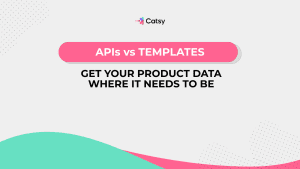eCommerce Catalog Management: What It Is and How to Do It Right

- eCommerce catalog management involves effectively organizing, structuring, and keeping product data up-to-date across all online sales channels.
- But this approach faces several challenges, such as maintaining accurate and consistent product information. On top of that, lack of robust features for enriching product details, and inefficient product information updates.
- Instead, a Product Information Management (PIM) solution is the right platform for eCommerce catalog management. It offers a centralized platform to streamline and optimize catalog management. This provides features like managing product variations, enriching product information with videos and images, and efficient updating of product information.
In this Article
Imagine yourself as a customer searching for a product online. You visit various websites, meticulously comparing prices, features, and reviews. Finally, you settle on a particular website to make your purchase. However, upon clicking on the product page, you are met with incomplete, inconsistent, or outdated information. This highlights the importance of efficient eCommerce catalog management. The images are blurry, the description is vague, and crucial specifications are missing. Furthermore, it emphasizes the need for meticulous management of the product catalog. As a result, you become frustrated and confused, ultimately leaving the website without completing your purchase.
As an online seller, you are determined to steer clear of such scenarios. Your ultimate objective is to offer your customers a seamless and delightful shopping experience. A space where they can effortlessly explore and purchase the products they truly desire. Most importantly, you aim for your products to rank highly on search engines, generating increased traffic, conversions, and sales.
There is no superior approach to achieving these objectives than embracing eCommerce catalog management. Throughout this article, we will elucidate the concept of eCommerce catalog management, emphasizing its importance for your online business. We will explore why you require a robust product information management (PIM) solution to achieve optimal outcomes. Especially, when managing the product catalog. Furthermore, we will provide invaluable best practices and tips to assist you in selecting the ideal PIM platform. This way you can achieve more efficient and effective catalog management.
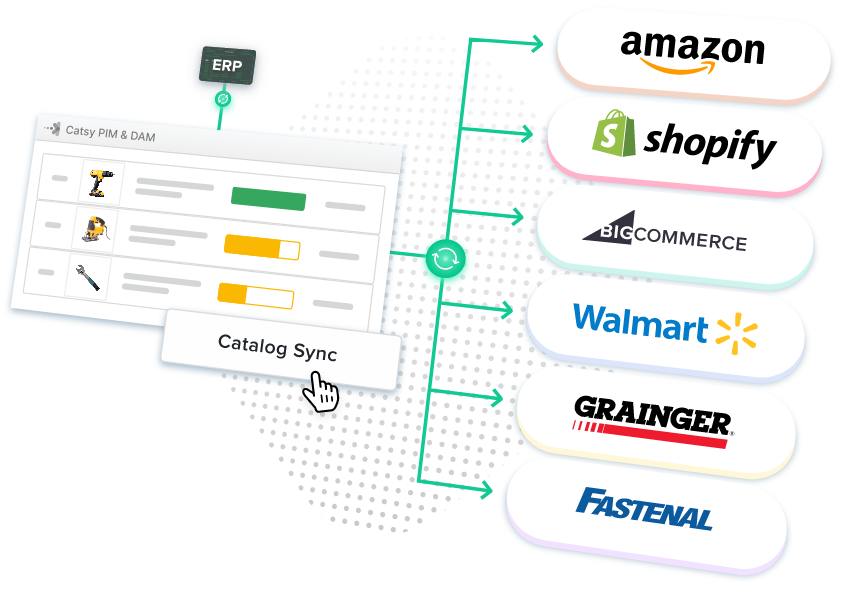
What is eCommerce Catalog Management?
A catalog can be defined as a comprehensive inventory of items arranged systematically. In the traditional sense of business, this organizational approach has proven indispensable and successful for sales. Its significance remains unaltered even in the era of eCommerce.
When eCommerce management tools are integrated with the organization of catalogs, the result is eCommerce catalog management. The primary goal is to ensure a consistent presentation of product information and marketing messages across various sales channels. This customer-centric sales strategy is of utmost importance and can determine the success or failure of online merchants. Hence, eCommerce catalog management encompasses every action and process that goes into organizing, structuring, and keeping product data up-to-date across all online sales channels. It achieves the following:
- Enhances the accuracy and integrity of product data by enabling the editing, addition, and modification of product information.
- Simplifies uploading product information to your product pages and automatically arranges and organizes the data.
- Facilitates the attraction of appropriate suppliers and retailers, mainly when providing B2B eCommerce services.
- Enables seamless integration with payment gateways and web content management systems.
The problem is that eCommerce catalogs involve a lot of manual work. Also, a product data management system built on this solution is challenging to scale. Some key challenges such a system presents include the following:
- Keeping product information accurate and consistent across all channels.
- Most catalogs lack robust features for enriching product information with details. Examples are videos, 360-degree views, or images, meaning customers do not get detailed product information.
- It does not provide the means to manage product variations and options. There is no way you can use product attributes. For example style, material, or color, to describe the variations of your products.
- eCommerce catalogs do not provide capabilities to update product information efficiently and more frequently.
It is clear that the challenge is to find a more effective product catalog management solution. That way, your online store stays afloat in today’s highly competitive environment. In other words, you need a more robust PIM solution to achieve optimal outcomes when managing the product catalog.
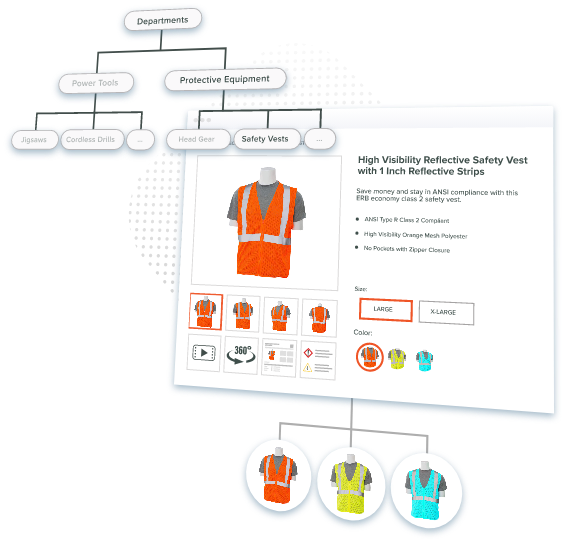
What is Product Information Management (PIM)?
Product Information Management (PIM) offers a powerful solution to streamline and optimize catalog management. With PIM, businesses gain the advantage of a centralized platform to efficiently gather, manage, govern, and enhance product information and content. This centralized approach ensures all stakeholders and processes can access reliable, up-to-date product content.
Benefits of PIM to Online Merchants
A PIM platform offers many benefits to online merchants. This includes the following:
- Simplifies and lowers the cost of managing product data derived from various sources and formats.
- Enhances the quality and precision of product data. This is by enabling standardization, validation, and enrichment with rich media such as documents, videos, or images.
- Expedites time-to-market and the product launch process by facilitating real-time updates and distribution of product information across multiple channels.
- Elevates the customer experience and satisfaction by providing relevant, comprehensive, and captivating product information that aids in making informed purchasing decisions.
- Boosts sales and revenue by enabling personalization, localization, and optimization of product information to cater to diverse audiences, markets, and channels.
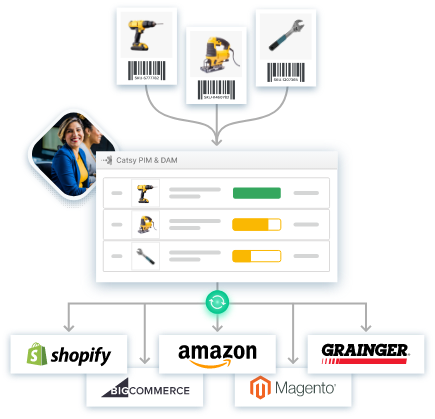
Key Features and Functions of PIM
- Centralized product data storage and management. PIM provides a central repository where businesses can store and manage all their product information in a structured manner. This centralized approach ensures data consistency and eliminates duplication or discrepancies when using multiple systems or spreadsheets.
- Automated data enrichment and validation. PIM systems often offer automated processes to enrich product data. This includes functionalities like data enrichment, standardization, and verification, using predefined rules and templates. Automation helps ensure the data adheres to predefined quality standards, accuracy, and completeness.
- Dynamic catalog creation and customization. PIM allows businesses to create customized digital catalogs tailored to specific customer segments, channels, or regions. It enables organizations to organize and present product information. Particularly, in a way that meets the unique requirements of different customer touchpoints and sales channels.
- Seamless integration with multiple sales channels and platforms. PIM systems provide capabilities to facilitate the integration of product data with various sales channels (such as b2b eCommerce websites and marketplaces) and platforms (such as mobile applications and print catalogs). Integration ensures consistent and synchronized product information across all channels, reducing manual effort and improving time-to-market.
- Advanced analytics and reporting tools. PIM solutions often provide analytics and reporting capabilities to gain insights into data quality, customer behavior, and, most critically, product performance. These tools help businesses make data-driven decisions, identify trends, and optimize product information strategies. Analytics may include metrics like data accuracy, sales performance, data completeness, and customer engagement.
- Workflow and collaboration management. PIM systems support collaboration and workflow management among cross-functional teams. They enable assigning tasks and setting up approval processes. Chiefly, the systems ensure data quality control throughout the product information management lifecycle. Workflow functionalities streamline collaboration and improve data governance within the organization.
- Localization and global data management. PIM solutions offer features to manage product data for different locales, languages, and regions. This includes support for measurement units, currency conversions, localized content, and other region-specific requirements. Additionally, PIM systems facilitate efficient global data management, enabling businesses to expand their reach across international markets.
- Integration with other enterprise systems. Although traditional catalogs can work in combination with business applications like ERP (Enterprise Resource Planning) and CRM (Customer Relationship Management), they do not provide the same utility as PIM solutions. In fact, some PIM platforms, such as Catsy PIM, have pre-built integrations with digital asset management software (DAM) solutions. This makes the product data enrichment process easy.
The involvement of a reliable PIM system can significantly impact a company’s ability to handle, enhance, and disseminate product data across numerous channels. By ensuring precise data, uniformity, and improved customer experiences, PIM becomes a crucial component of modern catalog management for eCommerce businesses. For those seeking a PIM solution, it’s essential to explore various options, such as Catsy PIM, and conduct a thorough comparison to find the most suitable alternative that aligns with their unique needs and available resources.
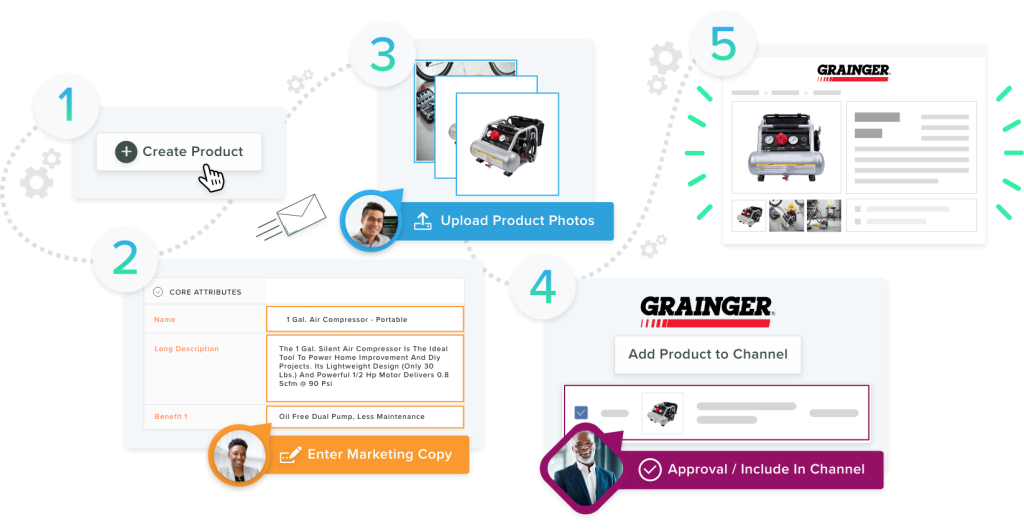
Overview on Product Data Lifecycle
Suppose you want to move your product data management system from traditional eCommerce catalog management-based tools to PIM platforms, and you want to enlighten yourself about how the new system works. In that case, here is a brief run-down of a PIM tool in action, including the eCommerce product catalog template. This run-down will focus on the product data lifecycle, i.e., data collection or consolidation to analytics and optimization.
- Data consolidation: Previously, your store’s product data was stored across multiple spreadsheets, documents, and platforms. With the implementation of a PIM system, you must begin by consolidating all information into the PIM platform. For each product on your products page, you must enter details like the name (title), descriptions, attributes (size, color, material), pricing, images, and stock availability.
- Enriching product data: Using the PIM system’s user-friendly interface, you can start enriching the product data by easily adding or modifying descriptions, specifications, and attributes for each item. For example, you can enhance product descriptions with compelling narratives, include accurate measurements, and assign relevant categories and tags to improve searchability.
- Validation and standardization: The PIM system automatically verifies the product data according to your set rules and standards. It checks if the provided information is accurate, complete, and consistent with your organizational practices. For instance, the system ensures that all required fields are populated, validates pricing formats, and enforces consistent attribute values across products.
- Dynamic catalog creation: We learned earlier that one of the critical features of a PIM solution is the ability to create and customize dynamic catalogs. Unlike other types of catalogs, dynamic catalogs can be generated on the fly using the PIM tool. It enables more interactivity, personalization, and flexibility. This catalog type can also be tailored to different customer segments and sales channels. You can define specific product assortments for your online site, mobile app, and third-party marketplaces. Most crucially, the PIM system allows you to optimize product information, select appropriate images, and customize product displays for each channel’s requirements.
- Integration with sales channels: With the technical phase of product data management complete, now it is time for distribution. To this end, the PIM system seamlessly integrates with your various sales channels. For example, it connects to your eCommerce platform, allowing real-time synchronization of product information. Whenever updates or new products are added to the PIM system, the changes automatically reflect on the website, ensuring consistent and up-to-date product data across all online channels.
- Workflow and collaboration: An online store often needs more than one person (or team) to run effectively. These teams must work together for the business to run smoothly. In this regard, the PIM system allows different teams to collaborate and accomplish various aspects of workflow to deliver excellent results quickly. For instance, the creative team can upload high-quality product images, which the product marketing team can review and approve for promotional material.
- Readiness reporting: The ultimate goal of a PIM system is to deliver high-quality and accurate product data. In this regard, the PIM platform tracks the consistency (i.e., ensures product descriptions align with organizational practices) and completeness (i.e., each product has sufficient metadata to enhance findability) of product information. This is the last step before users can publish the information to channels.
- Analytics and optimization: Obviously, you need the means to evaluate the effectiveness and utility of the new product data management system. The eCommerce PIM system provides advanced analytics and reporting tools that generate critical insights into the performance of each product. Also, the tools allow you to inspect the quality and completeness of the information for each showcased product.

How to Choose the Right PIM Solution for Your Online Store?
Like any other software platform, a PIM solution requires in-depth background searches and evaluation based on unique needs. You need sound measures to ensure you get the best platform for your needs, but the criteria must be a part of the process. Let’s explore some steps that may help you in this regard:
Step 1: Needs Assessment and Planning
You must start from a position of knowledge, assessing the current catalog management challenges and deciding what it will take to solve them. For example, a basic PIM tool is sufficient if the challenges include inconsistent product information, manual data entry, and difficulties in scaling and expanding product offerings. However, if you need a system that will help manage digital assets while performing, you must extend your search beyond standalone PIM platforms. Instead, you should focus on solutions that offer integrated PIM and DAM functionalities.
Step 2: Define Critical Features and Functionality
The needs assessment should give you a rough outline of the platform you need in terms of features and other aspects. But most importantly, it helps to understand that there are bare minimums that all PIM platforms must satisfy before you consider them; they include:
- Features: A PIM platform must offer standard features, like centralized data storage, the ability to enrich and validate information, channel-specific catalog customization, integration capabilities, workflow management, user access control, and analytics and reporting. However, the ideal PIM tool should offer advanced features like digital asset management, AI-driven data enrichment, API integrations, data syndication to multiple channels, and bulk editing capabilities.
- Pricing: PIM systems offer plenty of benefits, translating to a hefty sum when paying for the solution. However, different vendors provide different pricing levels, usually based on the range of features offered. You must carefully review pricing plans, understand any potential additional costs (e.g., implementation, training, support, data storage), and consider the solution’s scalability as your business grows.
- Support: The level and quality of support PIM vendors provide can vary. Thus, you must consider the support options available, such as email, phone, or chat support, as well as the vendor’s reputation for responsiveness and customer satisfaction.
- Compatibility: The ideal PIM solution should be compatible with the systems and platforms you currently use or plan to integrate with, such as eCommerce or marketplace platforms. Most importantly, it helps to consider the scalability of the PIM DAM solution and its ability to handle future integrations or expansions as your business requirements evolve.
Step 3: Research and Evaluate PIM Solutions
This phase is critical and borrows heavily from the results from phase one. Here, you will need to develop criteria to identify the ideal platform to satisfy, and even surpass, the needs you established earlier. You may need to ask questions like:
- How easy is the PIM platform to set up and use?
- Does it offer sufficient flexibility and customizability?
- How secure and reliable is it?
- Can it adapt to your store’s growing needs? If yes, how well can it do it?
- How well does it integrate with your existing eCommerce platform and other tools?
Based on the criteria, evaluate the solutions available in the market and conduct thorough research on different PIM vendors. For instance, you may want to read vendor websites, product documentation, and user reviews to gain insights into their offerings, features, and customer satisfaction. Take note of the solutions that pique your interest so that by the end of the evaluation, you will have a shortlist of PIM solutions that align with your business needs and have positive reputations.
Step 4: Demo and Proof of Concept
Most PIM solutions allow potential customers to schedule demos. Use this opportunity to tick off the solutions that do not fit your needs from the shortlist. The demo sessions will let you see each PIM solution in action, which is also the perfect time to learn how they work. It helps to prepare a list of specific questions and scenarios to ensure the PIM solution can address your unique requirements. Also, consider running a proof of concept (POC) with the selected vendors to test the solution’s capabilities using your actual product data and workflows. This helps assess its usability, performance, and suitability for your business.
Step 5: Evaluate Integration and Compatibility
During the demo sessions, assess the compatibility of each PIM solution with your existing systems and platforms. You may also want to review the available integrations and connectors the vendor provides. Some things to keep in mind at this stage include the ease and flexibility of integrating the PIM software with your current technology ecosystem.
Step 6: Consider Scalability
There is no telling how big your store will grow in the next few years, but we, at least, know that your product catalog will increase. The best PIM software must adapt to these changes and be able to deliver the same quality. As such, evaluate the scalability of the PIM solution to accommodate your future growth and evolving needs. Assess its ability to handle a more extensive product catalog, support multiple languages or regions, and adapt to changing business requirements.
Step 7: Vendor Support and Reputation
Before you make the final decision, do yourself an early favor and evaluate the vendor’s reputation, especially regarding their willingness to help clients out of entanglements. And the trick is to review the support options and then read customer reviews on platforms like Trustpilot. When examining the support options, consider the level of support provided, including the availability of documentation, training materials, and customer support responsiveness.
Above all else, you want an “easy button” solution to manage product catalogs for your online store. Catsy is one of the best PIM solutions that tick all the boxes we have established and goes the extra mile to ensure that even the greenest user can hit the ground running in a few hours of learning.
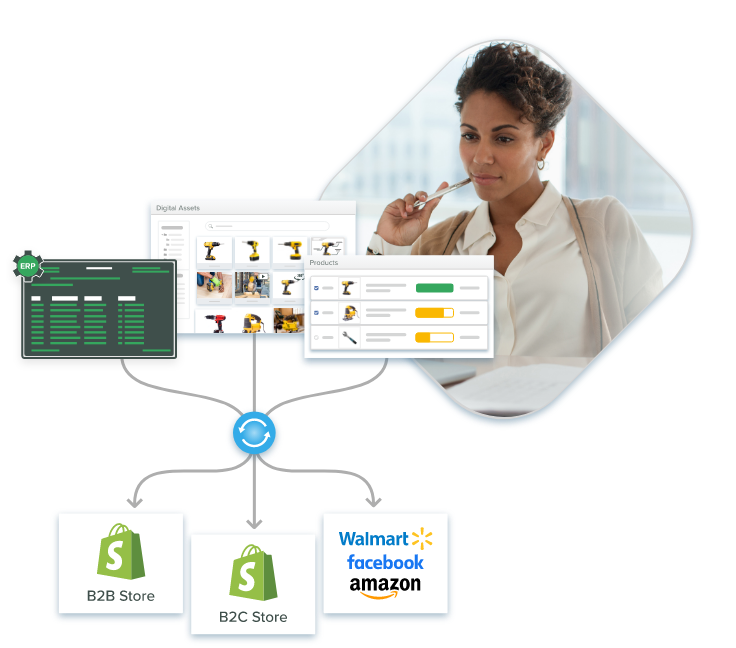
Conclusion
Product names, descriptions, specifications, and other data, as well as rich content like metadata, are the foundation of an eCommerce business. The information is organized in catalogs whose management defines the soundness of your online retail store. If you get catalog management right, nothing can stop the store from soaring. PIM platforms are the best tools for this job, but your solution choice will determine how well the tool serves your business.
As you strive to create a seamless and successful online retail store, leveraging a powerful Product Information Management (PIM) platform becomes paramount. Catsy, with its cutting-edge features and intuitive interface, stands out as a top-notch solution that can propel your business to new heights. By centralizing and optimizing your product data, Catsy ensures that your eCommerce store operates with unmatched precision and accuracy, empowering you to provide an exceptional customer experience. To witness the transformative capabilities of Catsy firsthand and explore how it can cater to your unique business needs, schedule a personalized demo with our team. Don’t miss this opportunity – schedule your demo today and take the first step towards revolutionizing your eCommerce business.
eCommerce catalog management involves organizing, structuring, and keeping product data up-to-date across all online sales channels to provide a seamless shopping experience to customers.
Some common challenges include maintaining accurate and consistent product information, a lack of robust features for enriching product details, and inefficient product information updates.
A PIM solution is a centralized platform that streamlines and optimizes catalog management processes, providing features like managing product variations, enriching product information with videos and images, and efficiently updating product information.
You can evaluate different PIM vendors based on criteria like adaptability, integration with existing platforms, and customer satisfaction. Conduct thorough research, read vendor websites, product documentation, and user reviews to make an informed decision. Schedule demos to see the PIM solutions in action and determine their suitability for specific business needs.
A PIM solution can help improve catalog management by streamlining processes like data consolidation, enriching product data, managing product variations, and efficiently updating product information. It can also provide a centralized platform to manage product data across all online sales channels, ensuring accurate and consistent product information.


